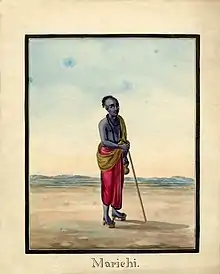Marichi
Rishi Marichi or Mareechi or Marishi (ṛṣi Marīci, ऋषि मरीचि) (meaning "ray of light") was the mindborn son of Brahma and one of the Saptarishi. He is also the father of Kashyapa and the grandfather of the Devas and Asuras.
| Marichi | |
|---|---|
| Member of The Saptarishi | |
 Marichi | |
| Personal information | |
| Parents |
|
| Spouse | Kalā |
| Children | Kashyapa |
He is the founder of Vedanta.[1] The one is referred to as one of the previous reincarnations of the 24th Tirthankara Mahavira.[2]
Saptarishi
Saptarishi, a Sanskrit dvigu meaning "seven sages" are the seven rishis who are extolled at many places in the Vedas and Hindu literature. The Vedic Samhitas never enumerate these rishis by name, though later Vedic texts such as the Brahmanas and Upanisads do so. While earlier texts do not mention Marichi as one of the seven, references can be found in the epic Mahabharata. In some parts of India, people believe these are seven stars of the Big Dipper named "Vashista", "Marichi", "Pulastya", "Pulaha", "Atri", "Angiras" and "Kratu". There is another star slightly visible within it, known as "Arundhati". He is considered one among the seven great sages, the saptarishis. Marichi, like some of the other sages, followed the path of worldly duties denouncing total renunciation. He had many children, the notable being sage Kashyapa. Dharmavrata was one of the many consorts of the sage. Once she was cursed by the sage to become a stone for no fault of her. She pleaded innocence and proved it by immolating herself. Vishnu was pleased by her devotion. She requested Vishnu to revert her curse, but Vishnu said that the curse could not be reverted, but she would continue to be regarded as Devashila, which would be considered sacred in every Hindu house.[3]
Prajapatis
Before the creation started, Brahma, the Hindu god of creation, needed a few people who can be held responsible for the creation of the remaining Universe. Therefore, he is believed to have created ten Prajapatis (Ruler of the people) from his Manas (mind) and nine from his body. Marichi is one of the manasputras of Brahma. The ten Prajapatis are as follows:[4]
Life
The life of Marichi is known more by the account of his descendants, notably by the works of sage Kashyapa. Marichi is then married to Kala and gave birth to Kashyapa (Kashyapa is also sometimes acknowledged as a Prajapati, who has inherited the right of creation from his father).[4] He is believed to be formed out of the sustained energy of the Hindu god Vishnu. He is believed to have officiated the penance of Brahma at Pushkar, found in modern-day Rajasthan. He, along with Narada, is also believed to have visited Bhishma during Mahabharatha, when he was lying on the arrow bed. Marichi is also quoted as the adviser of young Dhruva to pursue austerities. His name is featured in multiple Hindu scriptures like Brahmanda Purana and the Vedas.[3]
Krishna in the Bhagavad-Gita says, "Of the Ādityas I am Vishnu, of lights I am the radiant sun, of the Maruts I am Marici, and among the stars I am the moon."[5]
Jainism
In Jain scriptures, Marichi was the son of Bharata Chakravartin[6] who after many births was born as 24th Tirthankara of Jainism, Mahavira.[2] In his life as Marichi, he became a Jain monk following Rishabhanatha, first tirthankara, but was unable to follow the hard rules of Digambara penance. So he took a robe, pedals and an umberalla and founded his own religion taking Kapila as his first disciple.
See also
Notes
- http://www.sacred-texts.com/tantra/maha/maha00.htm
- Dundas 2002, p. 21.
- Sathyamayananda, Swami. Ancient sages. Mylapore, Chennai: Sri Ramakrishna Math. pp. 14–16. ISBN 81-7505-356-9.
- Wilkins, W.J. (2003). Hindu Mythology. New Delhi: D.K. Printworld (P) Limited. p. 370. ISBN 81-246-0234-4.
- Bhagavad Gita 10.21 Archived 4 March 2007 at the Wayback Machine
- Suriji, Acharya Gunaratna (2011). Confession: The Path to Self Liberation. Jingun Aaradhak Trust.